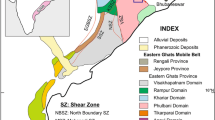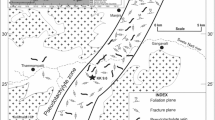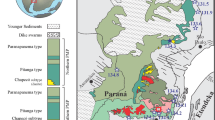Abstract
Quartz/feldspar fragment (‘clast’) sizes were measured in thin sections of three types of fault zone rocks, e.g., melting-dominated pseudotachylyte (M-Pt), crushing-dominated pseudotachylyte (C-Pt) and cataclasite (Ct), from two well-studied Precambrian shear/fault zones in the Indian craton (e.g., the Gavilgarh–Tan Shear zone in central India and the Sarwar–Junia Fault zone in western India). Logarithmic plots of clast area vs. cumulative frequency in the pseudotachylytes demonstrate a fractal clast-size distribution (c.s.d.) for the intermediate size range, whereas the finer and coarser clast size fractions clearly deviate from the fractal trend. Under-representation of the finer size clasts in the pseudotachylyte samples may be attributed to their preferential melting and removal from the clast population. The relative paucity of coarse clasts, on the other hand, is possibly due to a sampling bias against coarse clasts. The c.s.d of the cataclastic rock shows a multi-fractal character with two different slopes (i.e., lower D-value for finer clast sizes) and absence of the left-hand (finer size) fall off. This suggests less efficient crushing in the finer clast size fraction. The proportion of clasts, compared to the matrix, is very small in M-Pt, increases in C-Pt and is highest in Ct, suggesting that melting of rock/mineral fragments is a dominant process in forming M-Pt, whereas it is less significant in C-Pt, and is absent in Ct, which corroborates the microscopic observations.
Research Highlights
-
Clast size and cumulative frequency were measured in pseudotachylyte and cataclasite samples from two shear zones.
-
Size-frequency relationship follows a power law in melting- and crushing-dominated pseudotachylytes.
-
The power law does not hold good for the finest and coarsest size ranges in both types of pseudotachylytes.
-
For cataclasite, a multi-fractal power law relationship exists between the size and cumulative frequency of clasts.
-
The non-uniform power law relationship is explained by selective melting of finer clasts in pseudotachylyte.
-
Clast size distribution in a fault rock is likely controlled by the degree of melting involved in its genesis.







Similar content being viewed by others
References
Adhikari S and Pyne T K 1981 A report on the systematic geological mapping in parts of Tonk and Ajmer districts, Rajasthan; Unpubl. Report, Geol. Surv. India.
Berlenbach J W and Roering C 1992 Sheath-fold-like structures in pseudotachylytes; J. Struct. Geol. 14 847–856.
Bizzarri A 2014 The destiny of a clast within a molten pseudotachylyte vein; Bull. Seismol. Soc. Am. 104 2399–2411.
Blenkinsop T G 1991 Cataclasis and processes of particle size reduction; Pure Appl. Geophys. 136 59–86.
Chattopadhyay A and Khasdeo L 2011 Structural evolution of Gavilgarh–Tan Shear Zone, central India: A possible case of partitioned transpression during Mesoproterozoic oblique collision within Central Indian Tectonic Zone; Precamb. Res. 186 70–88.
Chattopadhyay A, Bhattacharjee D and Mukherjee S 2014 Structure of pseudotachylyte vein systems as a key to co-seismic rupture dynamics: The case of Gavilgarh–Tan shear zone, central India; Int. J. Earth Sci. 103 953–965.
Chattopadhyay A, Khasdeo L, Holdsworth R E and Smith S A F 2008 Fault reactivation and pseudotachylite generation in the semi-brittle and brittle regimes: Examples from the Gavilgarh–Tan Shear Zone, Central India; Geol. Mag. 145(6) 766–777.
Cowan D S 1999 Do faults preserve a record of seismic slip? A field geologist’s opinion; J. Struct. Geol. 21(8) 995–1001.
Di Toro G and Pennacchioni G 2004 Superheated friction-induced melts in zoned pseudotachylytes within the Adamello-tonalites (Italian Southern Alps); J. Struct. Geol. 26 1783–1801.
Golani P, Bandyopadhyay B and Gupta A 2001 Gavilgarh–Tan shear: A prominent ductile shear zone in Central India with multiple reactivation history; Geol. Surv. India, Special Publ. 64 265–272.
Gupta S N, Arora Y K, Mathur R K, Iqbaluddin P B, Sahai T N and Sharma S B 1980 Lithostratigraphic map of Aravalli region, southern Rajasthan and northern Gujarat; Geol. Surv. India, Calcutta.
Heron A M 1953 The geology of central Rajputana; Geol. Surv. India Memoir 79(1) 1–389.
Keulen N, Heilbronner R, Stünitz H, Boullier A M and Ito H 2007 Grain size distributions of fault rocks: A comparison between experimentally and naturally deformed granitoids; J. Struct. Geol. 29 1282–1300.
Kirkpatrick J D and Rowe C D 2013 Disappearing ink: How pseudotachylytes are lost from the rock record; J. Struct. Geol. 52 183–198.
Lin A 2008 Fossil earthquakes: The formation and preservation of pseudotachylytes; Lecture Notes in Earth Sci. 111, Springer.
Lin A 1996 Injection veins of crushing-originated pseudotachylyte and fault gouge formed during seismic faulting; Eng. Geol. 43(2) 213–224.
Lin A 1994 Glassy pseudotachylyte veins from the Fuyun fault zone, northwest China; J. Struct. Geol. 16(1) 71–83.
Maddock R H 1983 Melt origin of fault-generated pseudotachylytes demonstrated by textures; Geology 11(2) 105–108.
Magloughlin J F and Spray J G 1992 Frictional melting processes and products in geological materials: Introduction and discussion; Tectonophys. 204(3–4) 197–204.
Mandelbrot B 1982 The fractal geometry of nature; Freeman and Co, New York.
Mckenzie D and Brune J N 1972 Melting on fault planes during large earthquakes; Geophys. J. Roy. Astron. Soc. 29(1) 65–78.
Price N A, Johnson S E, Gerbi C C and West D P 2012 Identifying deformed pseudotachylyte and its influence on the strength and evolution of a crustal shear zone at the base of the seismogenic zone; Tectonophys. 518 63–83.
Ray S K 1999 Transformation of cataclastically deformed rocks to pseudotachylyte by pervasion of frictional melt: Inferences from clast-size analysis; Tectonophys. 301(3) 283–304.
Ray S K 2004 Melt–clast interaction and Power-law size distribution of clasts in pseudotachylytes; J. Struct. Geol. 26(10) 1831–1843.
Rice J R 2006 Heating and weakening of faults during earthquake slip; J. Geophys. Res. 111 B05311.
Sammis C, King G and Biegel R 1987 The kinematics of gouge deformation; Pure Appl. Geophys. 125(5) 777–812.
Sammis C G, Osborne R H, Anderson J L, Banerdt M and White P 1986 Self-similar cataclasis in the formation of fault gouge; Pure Appl. Geophys. 124(1–2) 53–78.
Sarkar A 2018 Mesoscopic, Microscopic and Geochemical study of pseudotachylytes: Understanding the frictional melting process in seismic fault zones; Unpublished PhD thesis, University of Delhi, India.
Sarkar A, Chattopadhyay A and Singh T 2019 Roundness of survivor clasts as a discriminator for melting and crushing origin of fault rocks: A reappraisal; J. Earth Syst. Sci. 128(3) 51.
Shimamoto T and Nagahama H 1992 An argument against the crush origin of pseudotachylytes based on the analysis of clast-size distribution; J. Struct. Geol. 14(8–9) 999–1006.
Sibson R H 1975 Generation of pseudotachylyte by ancient seismic faulting; Geophys. J. Roy. Astron. Soc. 43(3) 775–794.
Sibson R H 1977 Fault rocks and fault mechanisms; J. Geol. Soc. London 133(3) 191–213.
Spray J G 1995 Pseudotachylyte controversy: Fact or friction? Geology 23(12) 1119–1122.
Swaminath J and Mukherjee S K 1987 Annual General Report for the year 1981–82; Rec. Geol. Surv. India 116(1) 251.
Tsutsumi A 1999 Size distribution of clasts in experimentally produced pseudotachylytes; J. Struct. Geol. 21(3) 305–312.
Wenk H R 1978 Are pseudotachylytes products of fracture or fusion? Geology 6(8) 507–511.
Wise D U, Dunn D E, Engelder J T, Geiser P A, Hatcher R D, Kish S A, Odom A L and Schamel S 1984 Fault-related rocks: Suggestions for terminology; Geology 12 391–394.
Woodcock N H and Mort K 2008 Classification of fault breccias and related fault rocks; Geol. Mag. 145(03) 435–440.
Acknowledgements
Research on pseudotachylytes was supported by a research grant from University Grants Commission, Govt. of India (Grant No. F.42-66/2013(SR)) awarded to AC. Partial support from University of Delhi R&D Grant (No. RC/2015/9677) to AC is also acknowledged. AS acknowledges Project Fellowship from UGC. Department of Geology, University of Delhi provided the research infrastructure including the microscopy facility. Critical remarks by an anonymous reviewer and by the handling editor, Prof. Saibal Gupta, have helped in improving the paper considerably.
Author information
Authors and Affiliations
Contributions
Arindam Sarkar carried out the field work, collection of pseudotachylyte samples, microscopic study for identification of suitable thin sections, and a major part of the clast size measurement. He has also composed the figures and was partly involved in writing the paper. Dipanjan Bhattacharjee participated in the fieldwork, partly carried out the microscopic study and the clast size analysis. Anupam Chattopadhyay conceived the research project, guided the fieldwork and the laboratory studies, and mainly wrote the paper.
Corresponding author
Additional information
Communicated by Saibal Gupta
Rights and permissions
About this article
Cite this article
Sarkar, A., Bhattacharjee, D. & Chattopadhyay, A. Size distribution of survivor clasts in pseudotachylyte and cataclasite: Implications for crushing and melting processes in seismic fault zones. J Earth Syst Sci 129, 216 (2020). https://doi.org/10.1007/s12040-020-01480-3
Received:
Revised:
Accepted:
Published:
DOI: https://doi.org/10.1007/s12040-020-01480-3




